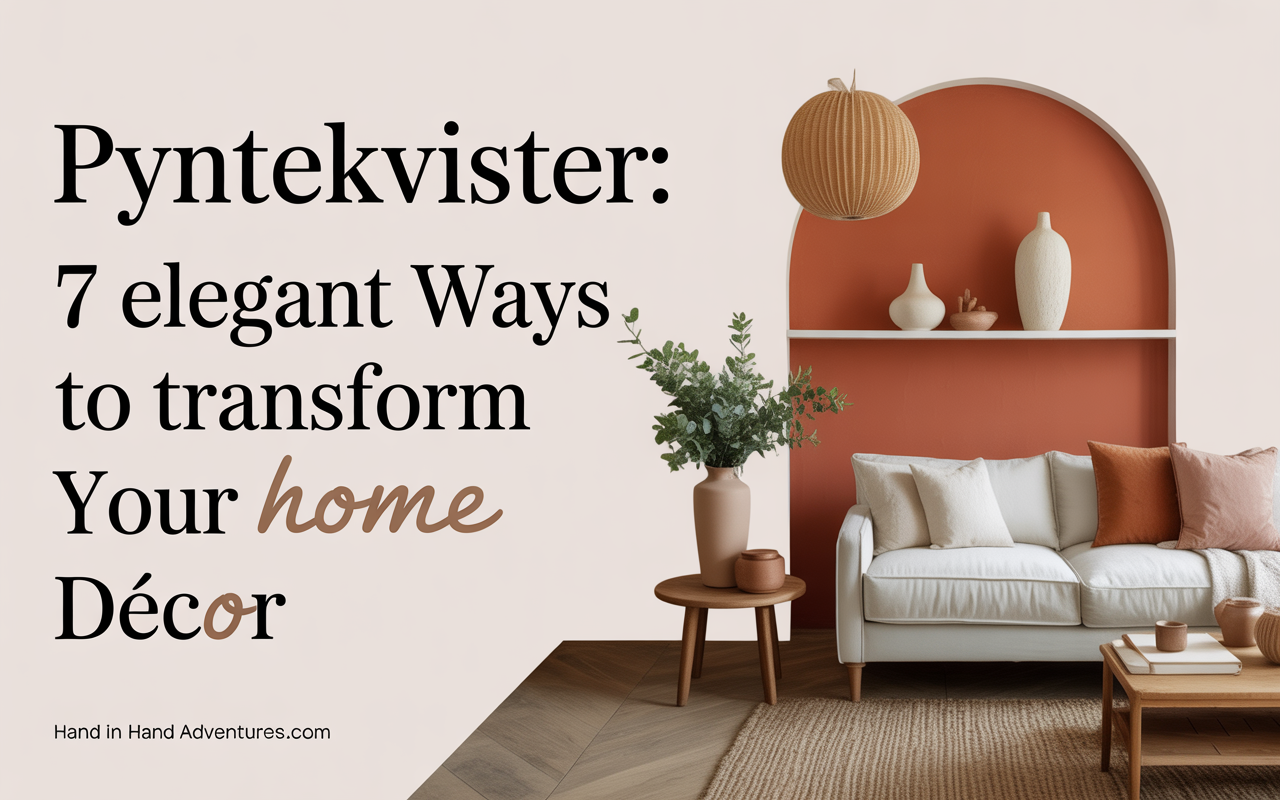Pyntekvister, a word rooted in Scandinavian languages, translates roughly to “decorative branches.” These natural adornments have gained remarkable popularity across the world as people embrace Nordic-inspired minimalism and biophilic design. In essence, Pyntekvister embodies the art of bringing the outdoors in—combining the raw beauty of twigs, branches, and organic textures to create a serene, balanced atmosphere within the home.
The concept extends beyond decoration; it represents a lifestyle deeply connected to simplicity, sustainability, and emotional well-being. Whether used in vases, hung as wall décor, or arranged in seasonal displays, Pyntekvister invites nature’s calm energy into modern spaces.
Pyntekvister and Scandinavian Design
In Scandinavian design, less is more. Pyntekvister perfectly encapsulates this philosophy by emphasizing simplicity, authenticity, and connection with nature. Rather than flashy embellishments, the focus lies in natural materials—birch, willow, or driftwood—and neutral tones that evoke tranquility. When paired with minimalist furniture and soft lighting, these decorative branches become focal points that elevate interior harmony.
The use of Pyntekvister reflects the Scandinavian concept of hygge—the feeling of coziness and contentment achieved through simplicity and comfort. By integrating natural textures, a room instantly feels more grounded and inviting.
The Natural Essence Behind Pyntekvister
What makes Pyntekvister truly unique is its connection to nature’s imperfect beauty. Each branch, with its twists and irregularities, tells a story. The materials commonly used—birch twigs, willow branches, or dried eucalyptus—bring organic charm and fragrance indoors. The aesthetic versatility allows them to blend seamlessly with wood, metal, glass, or stone surfaces.
Natural variations in texture and color mean no two arrangements are ever the same. This individuality enhances authenticity, a quality increasingly sought in modern interior design.
Choosing the Perfect Pyntekvister for Your Space
When selecting Pyntekvister, consider proportion, tone, and the surrounding environment. Tall, slender branches work well in spacious rooms, while shorter ones suit compact spaces or table centerpieces. Color is another vital factor—white birch suits minimalist rooms, while darker woods complement rustic interiors.
Seasonal selections also add freshness. For spring, use budding branches or blossoms; for autumn, golden-hued twigs or berry accents enrich warmth.
DIY Pyntekvister Projects
Creating your own Pyntekvister can be a rewarding experience. Start by gathering branches from your garden or local park—ensure they are clean and dry. Arrange them in varying heights for visual depth. Add dried flowers, ribbons, or fairy lights for a personalized touch.
Another creative idea is painting the branches white or metallic for a festive flair. You could even hang ornaments, paper cutouts, or seasonal decorations for a customized display.
Seasonal Styling Ideas with Pyntekvister
Pyntekvister adapts beautifully to any season. In spring, pair them with pastel blooms for a refreshing look. Summer arrangements can incorporate sea glass or driftwood for coastal charm. Autumn designs benefit from copper tones and dried leaves, while winter décor shines with frosted branches and candles.
The ability to transition effortlessly through seasons makes Pyntekvister a timeless addition to any home.
Pyntekvister in Modern Interiors
In modern design, Pyntekvister introduces softness and organic balance to sleek, geometric forms. Whether placed in minimalist glass vases or mounted as wall art, the natural lines contrast elegantly with contemporary materials like marble or steel. This fusion of modern and organic elements adds depth and character without overwhelming the space.
Traditional Uses of Pyntekvister
Historically, Pyntekvister were part of Scandinavian rituals and seasonal celebrations. During Easter, families would decorate branches with colorful feathers and ornaments, symbolizing renewal. Similarly, at Christmas, evergreen twigs and pine cones represented hope and endurance through winter.
These traditions have evolved, but the emotional connection remains strong—Pyntekvister continues to evoke nostalgia and harmony.
How to Care for Your Pyntekvister
Maintenance is simple yet essential. Dust regularly using a soft cloth or brush. For dried or preserved branches, avoid direct sunlight to prevent fading. If using live branches, refresh water every few days to maintain vitality. Spraying lightly with a natural oil can also preserve luster and aroma.
Combining Pyntekvister with Other Décor Elements
Mixing textures enhances depth and interest. Combine Pyntekvister with candles, ceramics, glassware, or textiles to achieve layered harmony. Using neutral tones ensures the natural branches remain the star of the composition. For a bolder approach, add pops of color through flowers or vases.
Pyntekvister for Festive Occasions
Pyntekvister makes festive decorating easy and sustainable. Adorn them with small ornaments for Christmas, feathers for Easter, or flowers for midsummer celebrations. Their adaptability eliminates the need for wasteful plastic decorations while keeping traditions alive in a stylish, modern way.
Eco-Friendly Aspects of Pyntekvister
Sustainability is at the heart of Pyntekvister décor. Since natural branches are biodegradable and reusable, they represent an eco-conscious alternative to synthetic décor. By reusing or repurposing them each season, homeowners reduce environmental waste while maintaining aesthetic charm.
Where to Buy Authentic Pyntekvister
Authentic Pyntekvister can be found in Scandinavian design boutiques, online artisan marketplaces, or local florists. Look for ethically sourced materials and handmade craftsmanship for best results. Supporting small artisans not only ensures quality but also preserves cultural authenticity.
The Art of Arranging Pyntekvister
Composition matters. To achieve balance, start with a focal branch and arrange others around it in varied heights. Negative space is crucial—too many branches can overwhelm. Experiment with asymmetrical designs for a modern feel or symmetrical ones for classical beauty.
Pyntekvister in Outdoor Spaces
Extend the charm outdoors by incorporating Pyntekvister into garden décor or balcony arrangements. They can be used in pots, along pathways, or in outdoor lighting setups to create continuity between indoor and outdoor aesthetics.
The Emotional Impact of Pyntekvister
Beyond decoration, Pyntekvister influences mood. Studies show that natural elements in interior design reduce stress and enhance focus. Their organic form promotes calmness, making them ideal for meditation areas or workspaces.
Minimalist vs. Ornate Pyntekvister
Minimalists often prefer unadorned branches in neutral tones, while ornate stylists add embellishments like crystals or dried flowers. Both approaches highlight different facets of beauty—simplicity versus grandeur.
Pyntekvister and Color Psychology
Colors evoke emotions. Soft whites and greys bring serenity, browns add warmth, and metallics symbolize festivity. Understanding these subtleties helps in crafting harmonious interior compositions.
How Influencers Use Pyntekvister
Scandinavian influencers often showcase Pyntekvister arrangements on Instagram and Pinterest. Their creativity demonstrates versatility—from rustic kitchen displays to luxurious living room accents—proving that natural décor remains timeless.
The Role of Lighting with Pyntekvister
Lighting enhances the visual appeal. Soft, warm light emphasizes textures, while cooler tones highlight silhouettes. Experimenting with fairy lights or candles can transform simple branches into magical centerpieces.
Affordable Ways to Style Pyntekvister
Beauty need not be expensive. Recycle old jars as vases, collect branches locally, and use minimal accessories. The charm of Pyntekvister lies in simplicity, making it budget-friendly yet elegant.
Common Mistakes When Styling Pyntekvister
Overcrowding or mismatched tones can disrupt harmony. Ignoring proportion or balance leads to visual clutter. Always step back to view the arrangement from different angles before finalizing placement.
The Future of Pyntekvister Décor
As sustainability and minimalism shape global design trends, Pyntekvister is poised for lasting relevance. Future designs may incorporate smart lighting or 3D-printed holders while retaining organic authenticity.
Conclusion
Pyntekvister stands as a symbol of natural elegance, sustainability, and timeless Scandinavian charm. Whether you’re decorating a cozy apartment or a spacious villa, these decorative branches transform interiors with effortless beauty. Their adaptability, eco-friendly nature, and emotional resonance make them a design staple that bridges modern living with the serenity of nature.

